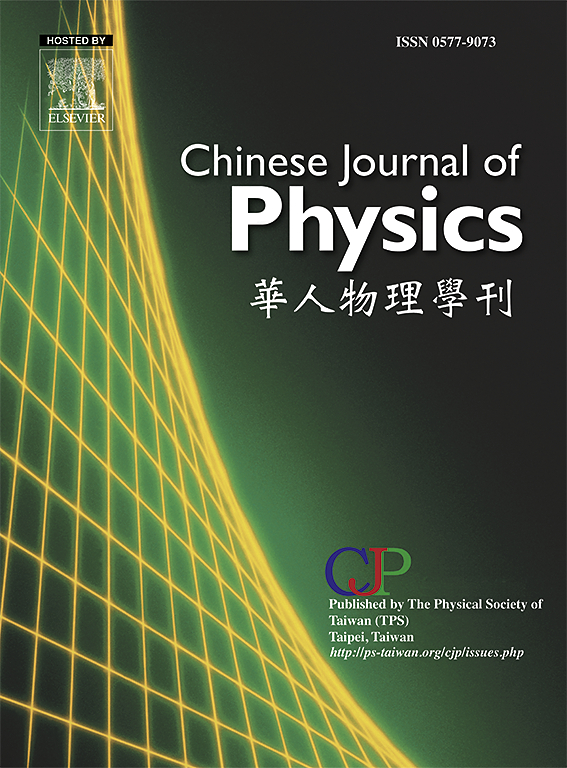Pattern dynamics in a predator–prey model with Smith growth function and prey refuge in predator poisoned environment
IF 4.6
2区 物理与天体物理
Q1 PHYSICS, MULTIDISCIPLINARY
引用次数: 0
Abstract
In this article, we investigate temporal as well as spatiotemporal dynamics of a predator–prey system where prey grows according to Smith growth function and prey refuges in predator poisoned environment. Self as well as cross diffusion are taken into consideration to describe spatial moment of the species which make the system more realistic. This study aims to investigate the role of prey refuge, toxin-carrying carcass and the impact of cross-diffusion on the spatial distribution of species densities and associated patterns. The existence of equilibria and their stability conditions for non-spatial system are derived. We discuss the occurrence of Hopf bifurcation and detect the stability of limit cycle by computing first Lyapunov number. Temporal dynamics of the system is studied by varying the significant parameters. Study reveals that both prey refuge and fatality rate of predator due to toxin-carrying carcass, initially makes the system stable for low refuge and fatality rate but predator population goes to extinction as those effects increase. Turing instability conditions are listed and different instability regions so formed are discussed. In Turing region, pattern selection with the help of amplitude equation via weakly nonlinear analysis are performed which also numerically supported. Intensity of refuge and fatality rate due to toxin carrying carcass result paradox with real ecological world due to the presence of cross diffusion. Various kind of patterns such as mixture of stripe and spot, spot, irregular chaotic patterns emerge due to Hopf and Turing instability. Particularly, spatiotemporal chaos is a controversial topic because of its significant consequences for population dynamics. The results of this work are expected to contribute to a better understanding the level of prey refuge, use of toxin-carrying carcass considering movement in population and effect of cross-diffusion.
带有斯密增长函数的捕食者-猎物模型中的模式动力学以及捕食者中毒环境中的猎物避难所
在本文中,我们研究了捕食者-猎物系统的时空动态,在该系统中,猎物根据斯密生长函数生长,猎物在捕食者中毒的环境中避难。在描述物种的空间力矩时,考虑了自扩散和交叉扩散,这使得系统更加逼真。本研究旨在探讨猎物避难所、携带毒素的尸体以及交叉扩散对物种密度空间分布和相关模式的影响。我们推导了非空间系统的平衡点及其稳定性条件。我们讨论了霍普夫分岔的发生,并通过计算第一个 Lyapunov 数检测了极限循环的稳定性。通过改变重要参数研究了系统的时间动力学。研究发现,在低避难率和低死亡率情况下,猎物避难率和捕食者因携带毒素的尸体而死亡的比率会使系统保持稳定,但随着这些影响的增加,捕食者种群会走向灭绝。本文列出了图灵不稳定条件,并讨论了由此形成的不同不稳定区域。在图灵区域,通过弱非线性分析,借助振幅方程进行模式选择,这也得到了数值支持。由于交叉扩散的存在,带毒胴体导致的避难强度和死亡率与现实生态世界存在矛盾。由于霍普夫不稳定性和图灵不稳定性,出现了各种模式,如条纹和斑点混合模式、斑点模式、不规则混沌模式。特别是时空混沌是一个有争议的话题,因为它对种群动力学有重大影响。这项工作的结果有望有助于更好地理解猎物的避难水平、考虑到种群运动的带毒尸体的利用以及交叉扩散的影响。
本文章由计算机程序翻译,如有差异,请以英文原文为准。
求助全文
约1分钟内获得全文
求助全文
来源期刊

Chinese Journal of Physics
物理-物理:综合
CiteScore
8.50
自引率
10.00%
发文量
361
审稿时长
44 days
期刊介绍:
The Chinese Journal of Physics publishes important advances in various branches in physics, including statistical and biophysical physics, condensed matter physics, atomic/molecular physics, optics, particle physics and nuclear physics.
The editors welcome manuscripts on:
-General Physics: Statistical and Quantum Mechanics, etc.-
Gravitation and Astrophysics-
Elementary Particles and Fields-
Nuclear Physics-
Atomic, Molecular, and Optical Physics-
Quantum Information and Quantum Computation-
Fluid Dynamics, Nonlinear Dynamics, Chaos, and Complex Networks-
Plasma and Beam Physics-
Condensed Matter: Structure, etc.-
Condensed Matter: Electronic Properties, etc.-
Polymer, Soft Matter, Biological, and Interdisciplinary Physics.
CJP publishes regular research papers, feature articles and review papers.
 求助内容:
求助内容: 应助结果提醒方式:
应助结果提醒方式:


